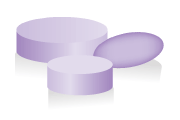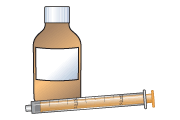Amitriptyline for neuropathic pain
This leaflet is for parents and carers about how to use this medicine in children. Our information may differ from that provided by the manufacturers, because their information usually relates to adults. Read this leaflet carefully. Keep it somewhere safe so that you can read it again.
Do not stop giving this medicine suddenly, as your child could get withdrawal symptoms.
Name of medicine
Amitriptyline (sometimes known as amitriptyline hydrochloride)
Why is it important for my child to take Amitriptyline?
Amitriptyline will help your child to feel less pain. The pain may be described as having a burning, shooting or scalding sensation.
What is Amitriptyline available as?
- Tablets: 10 mg, 25 mg, 50 mg; these all contain small amounts of lactose
- Liquid medicine: 25 mg or 50 mg in 5 mL
When should I give Amitriptyline
Give the medicine at about the same time(s) each day so that this becomes part of your child’s daily routine, which will help you to remember.
Amitriptyline may be given once or twice a day.
- Once a day: This is usually in the evening.
- Twice a day: This should be once in the morning and once in the evening. Ideally, these times are 10–12 hours apart, for example sometime between 7am and 8am and between 7pm and 8pm.
How much should I give?
Your doctor will work out the amount of Amitriptyline (the dose) that is right for your child. The dose will be shown on the medicine label.
Your doctor may suggest that your child starts with a low dose. They may then increase the dose as your child gets used to the medicine and depending on how they respond to it. Your doctor will explain what to do. If you are not sure how much to give, check with your doctor, nurse or pharmacist.
It is important that you follow your doctor’s instructions about how much to give.
How should I give Amitriptyline?

Tablets
- Tablets should be swallowed with a glass of water, squash or juice. Your child should not chew the tablet.

Liquid medicine
- Shake the medicine well.
- Measure out the right amount using an oral syringe or a medicine spoon. You can get these from your pharmacist. Do not use a kitchen teaspoon as it will not give the right amount.
When should the medicine start working?
It may take a few days or even weeks for Amitriptyline to work properly, so your child may still have their symptoms for a while. This is because the amount of medicine has to be increased slowly. Continue to give the medicine as you have been told to by your doctor.
What if my child is sick (vomits)?
- If your child is sick less than 30 minutes after having a dose of Amitriptyline, give them the same dose again.
- If your child is sick more than 30 minutes after having a dose of Amitriptyline, do not give them another dose. Wait until the next normal dose.
If your child is sick again, seek advice from your family doctor, nurse, pharmacist, or hospital. They will decide what to do based on your child’s condition and the specific medicine involved.
What if I forget to give it?
If you usually give it once a day in the evening: If you remember before bedtime, give the missed dose. You do not need to wake a sleeping child to give a missed dose. You can give the missed dose in the morning, as long as this is at least 12 hours before the evening dose is due.
If you usually give Amitriptyline twice a day: If you forget to give Amitriptyline, do not give the missed dose. Wait until the next normal dose.
Never give a double dose of Amitriptyline.
If you have forgotten to give more than one dose, contact your doctor for advice.
What if I give too much?
If your child has any, or all, of the following symptoms, they may have had too much amitriptyline.
- The pupils (the black circles in the centre of the eye) may become very large.
- Your child may become very sleepy.
- They may have difficulty breathing, or their breathing may be slow.
- Their heart may race.
- Your child’s skin feels hot to touch.
If there is any possibility that you may have given your child too much amitriptyline, take them to hospital or telephone for an ambulance straight away. Tell the doctor that your child may have had too much amitriptyline.
Take the medicine container or packet with you, even if it is empty. This will be useful to the doctor. Have the packet with you if you telephone for advice.
It can be dangerous to give too much Amitriptyline.
Are there any possible side effects?
We use medicines to make our children better, but sometimes they have other effects that we don’t want (side effects).
Side effects you must do something about
If your child has an irregular or fast heart rate (fluttery or racing), contact your doctor straight away.
If your child has problems with their eyesight (e.g. blurred or double vision), contact your doctor straight away.
Other side-effects you need to know about
- When they first start taking Amitriptyline, your child may feel sweaty, feel sick (nausea), have constipation (difficulty doing a poo) or find it difficult to pass urine (do a wee). These symptoms should settle down after a week or so as your child’s body gets used to the medicine. If your child still has any of these symptoms after 2 weeks, or you are worried, contact your doctor.
Your child may feel sleepy for a few hours after having a dose of Amitriptyline. This is why it is best to give Amitriptyline in the evening.
Your child may have a dry mouth. Eating citrus fruits (e.g. oranges) and sipping water may help.
There may sometimes be other side effects that are not listed above. If you notice anything unusual and are concerned, contact your doctor. You can report any suspected side effects to a UK safety scheme at mhra.gov.uk/yellowcard
Can other medicines be given at the same time as Amitriptyline?
- You can give your child medicines that contain paracetamol or ibuprofen, unless your doctor has told you not to.
- Amitriptyline should not be taken with some medicines. Tell your doctor or pharmacist about any other medicines your child is taking before giving Amitriptyline.
Check with your doctor or pharmacist before giving any other medicines to your child. This includes herbal and complementary medicines.
Is there anything else I need to know about this medicine?
If your child has ever had a problem with their heart, tell your doctor before giving Amitriptyline.
Do not stop taking Amitriptyline suddenly, as your child may get withdrawal effects (dizziness, feeling sick, pins and needles, headache and anxiety).
- If your doctor decides to stop a particular medicine, they will discuss this with you. You will usually reduce the dose bit by bit. Your doctor will explain how to do this. Do not change the dose without talking to your doctor first.
- If Amitriptyline does not seem to be helping your child’s symptoms, contact your doctor for advice. Remember that it may take a few days or weeks for the medicine to work. Do not give extra doses of Amitriptyline.
- The liquid medicine comes in several strengths. Make a note of which one you usually have and check that you have been given the right one each time.
- Amitriptyline is also used to treat depression but this is at a higher dose than used to treat neuropathic pain. The drug works in different ways at different doses.
General advice about medicines
- Try to give medicines at about the same times each day, to help you remember.
- Only give this medicine to your child. Never give it to anyone else, even if their condition appears to be the same, as this could do harm.
- Make sure that you always have enough medicine. Order a new prescription at least 2 weeks before you will run out.
- Make sure that the medicines you have at home have not reached the ‘best before’ or ‘use by’ date on the packaging. Give old medicines to your pharmacist to dispose of.
If you think someone else may have taken the medicine by accident, contact your doctor straight away.
Where should I keep this medicine?
- Keep the medicine in a cupboard, away from heat and direct sunlight.
- It does not need to be kept in the fridge.
- Make sure that children cannot see or reach the medicine.
- Keep the medicine in the container it came in.
Who to contact for more information?
Your child’s doctor or pharmacist will be able to give you more information about Amitriptyline and other medicines used to treat neuropathic pain.
England: NHS 111
Tel 111
www.nhs.ukScotland: NHS 24
Tel 111
www.nhs24.scotNorthern Ireland: NI Direct
Wales: NHS 111 Wales
Tel 111
www.111.wales.nhs.ukCopyright disclaimer
Version [2]. © NPPG, RCPCH and WellChild, all rights reserved. Review by January 2017.
The primary source for the information in this leaflet is the British National Formulary for Children. For details on any other sources used for this leaflet, please contact us through our website, www.medicinesforchildren.org.uk.
We take great care to make sure that the information in this leaflet is correct and up-to-date. However, medicines can be used in different ways for different patients. It is important that you ask the advice of your doctor or pharmacist if you are not sure about something. This leaflet is about the use of these medicines in the UK, and may not apply to other countries. The Royal College of Paediatrics and Child Health (RCPCH), the Neonatal and Paediatric Pharmacists Group (NPPG), WellChild and the contributors and editors cannot be held responsible for the accuracy of information, omissions of information, or any actions that may be taken as a consequence of reading this leaflet.
